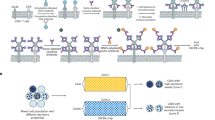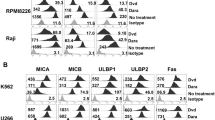Abstract
Multivesicular bodies (MVBs) are endocytic compartments that contain intraluminal vesicles formed by inward budding from the limiting membrane of endosomes. In T lymphocytes, these vesicles contain pro-apoptotic Fas ligand (FasL), which may be secreted as ‘lethal exosomes’ upon fusion of MVBs with the plasma membrane. Diacylglycerol kinase α (DGKα) regulate the secretion of exosomes, but it is unclear how this control is mediated. T-lymphocyte activation increases the number of MVBs that contain FasL. DGKα is recruited to MVBs and to exosomes in which it has a double function. DGKα kinase activity exerts a negative role in the formation of mature MVBs, as we demonstrate by the use of an inhibitor. Downmodulation of DGKα protein resulted in inhibition of both the polarisation of MVBs towards immune synapse and exosome secretion. The subcellular location of DGKα together with its complex role in the formation and polarised traffic of MVBs support the notion that DGKα is a key regulator of the polarised secretion of exosomes.
Similar content being viewed by others
Log in or create a free account to read this content
Gain free access to this article, as well as selected content from this journal and more on nature.com
or
Abbreviations
- Ab:
-
antibody
- AICD:
-
activation-induced cell death
- CCh:
-
carbamyl choline (carbachol)
- CTL:
-
cytotoxic T lymphocyte
- DAG:
-
diacylclycerol
- DGK:
-
diacylglycerol kinase
- ESCRT:
-
endosomal sorting complex required for transport
- FACS:
-
fluorescence-activated cell sorter
- FasL:
-
Fas ligand
- HM1R:
-
human muscarinic receptor type 1
- HRP:
-
horseradish peroxidase
- mAb:
-
monoclonal antibody
- ILVs:
-
intraluminal vesicles
- LBPA:
-
lysobisphosphatidic acid
- MTOC:
-
microtubule organising centre
- MVBs:
-
multivesicular bodies
- PM:
-
plasma membrane
- SEE:
-
Staphylococcal Enterotoxin E
- TCR:
-
T-cell receptor
- TGN:
-
trans-golgi network
- WB:
-
western blot
References
Stoorvogel W, Kleijmeer MJ, Geuze HJ, Raposo G . The biogenesis and functions of exosomes. Traffic 2002; 3: 321–330.
Bossi G, Griffiths GM . Degranulation plays an essential part in regulating cell surface expression of Fas ligand in T cells and natural killer cells. Nat Med 1999; 5: 90–96.
Nagata S . Apoptosis by death factor. Cell 1997; 88: 355–365.
Zuccato E, Blott EJ, Holt O, Sigismund S, Shaw M, Bossi G et al. Sorting of Fas ligand to secretory lysosomes is regulated by mono-ubiquitylation and phosphorylation. J Cell Sci 2007; 120: 191–199.
Monleon I, Martinez-Lorenzo MJ, Monteagudo L, Lasierra P, Taules M, Iturralde M et al. Differential secretion of Fas ligand- or APO2 ligand/TNF-related apoptosis-inducing ligand-carrying microvesicles during activation-induced death of human T cells. J Immunol 2001; 167: 6736–6744.
Martinez-Lorenzo MJ, Anel A, Gamen S, Monleon I, Lasierra P, Larrad L et al. Activated human T cells release bioactive Fas ligand and APO2 ligand in microvesicles. J Immunol 1999; 163: 1274–1281.
Andreola G, Rivoltini L, Castelli C, Huber V, Perego P, Deho P et al. Induction of lymphocyte apoptosis by tumor cell secretion of FasL-bearing microvesicles. J Exp Med 2002; l95: 1303–1316.
Alonso R, Rodriguez MC, Pindado J, Merino E, Merida I, Izquierdo M . Diacylglycerol kinase alpha regulates the secretion of lethal exosomes bearing Fas ligand during activation-induced cell death of T lymphocytes. J Biol Chem 2005; 280: 28439–28450.
Kayagaki N, Kawasaki A, Ebata T, Ohmoto H, Ikeda S, Inoue S et al. Metalloproteinase-mediated release of human Fas ligand. J Exp Med 1995; 182: 1777–1783.
Topham MK, Prescott SM . Mammalian diacylglycerol kinases, a family of lipid kinases with signaling functions. J Biol Chem 1999; 274: 11447–11450.
Sanjuan MA, Jones DR, Izquierdo M, Merida I . Role of diacylglycerol kinase alpha in the attenuation of receptor signaling. J Cell Biol 2001; 153: 207–220.
Strasser A . Death of a T cell. Nature 1995; 373: 385–386.
Izquierdo M, Ruiz-Ruiz MC, Lopez-Rivas A . Stimulation of the Ptdlns turnover is a key event for Fas-dependent, activation-induced apoptosis in human T lymphocytes. J Immunol 1996; 157: 21–28.
Roth MG . Lipid regulators of membrane traffic through the golgi complex. Trends Cell Biol 1999; 9: 174–179.
Baron CL, Malhotra V . Role of diacylglycerol in PKD recruitment to the TGN and protein transport to the plasma membrane. Science 2002; 295: 325–328.
Sprong H, van der Sluijs P, van Meer G . How proteins move lipids and lipids move proteins. Nat Rev Mol Cell Biol 2001; 2: 504–513.
Quann EJ, Merino E, Furuta T, Huse M . Localized diacylglycerol drives the polarization of the microtubule-organizing center in T cells. Nat Immunol 2009; 10: 627–635.
Vanlandingham PA, Ceresa BP . Rab7 regulates late endocytic trafficking downstream of multivesicular body biogenesis and cargo sequestration. J Biol Chem 2009; 284: 12110–12124.
Clark RH, Stinchcombe JC, Day A, Blott E, Booth S, Bossi G et al. Adaptor protein 3-dependent microtubule-mediated movement of lytic granules to the immunological synapse. Nat Immunol 2003; 4: 1111–1120.
Alonso R, Mazzeo C, Merida I, Izquierdo M . A new role of diacylglycerol kinase alpha on the secretion of lethal exosomes bearing Fas ligand during activation- induced cell death of T lymphocytes. Biochimie 2007; 89: 213–221.
Jiang Y, Sakane F, Kanoh H, Walsh JP . Selectivity of the diacylglycerol kinase inhibitor 3-[2-(4-[bis-(4-fluorophenyl)methylene]-l-piperidinyl)ethyl]-2, 3-dihydro-2-thioxo-4(1H)quinazolinone (R59949) among diacylglycerol kinase subtypes. Biochem Pharmacol 2000; 59: 763–772.
Bishop N, Woodman P . ATPase-defective mammalian VPS4 localizes to aberrant endosomes and impairs cholesterol trafficking. Mol Biol Cell 2000; 11: 227–239.
Fujita H, Yamanaka M, Imamura K, Tanaka Y, Nara A, Yoshimori T et al. A dominant negative form of the AAA ATPase SKD1/VPS4 impairs membrane trafficking out of endosomal/lysosomal compartments: class E vps phenotype in mammalian cells. J Cell Sci 2003; 116: 401–414.
Montoya MC, Sancho D, Bonello G, Collette Y, Langlet C, He HT et al. Role of ICAM-3 in the initial interaction of T lymphocytes and APCs. Nat Immunol 2002; 3: 159–168.
Sato M, Ueda Y, Umezawa Y . Imaging diacylglycerol dynamics at organelle membranes. Nat Methods 2006; 3: 797–799.
Matsuo H, Chevallier J, Mayran N, Le Blanc I, Ferguson C, Faure J et al. Role of LBPA and Alix in multivesicular liposome formation and endosome organization. Science 2004; 303: 531–534.
Kobayashi T, Beuchat MH, Chevallier J, Makino A, Mayran N, Escola JM et al. Separation and characterization of late endosomal membrane domains. J Biol Chem 2002; 277: 32157–32164.
Carrasco S, Merida I . Diacylglycerol-dependent binding recruits PKC(theta) and RasGRPl Cl domains to specific subcellular localizations in living T lymphocytes. Mol Biol Cell 2004; 15: 2932–2942.
Desai DM, Newton ME, Kadlecek T, Weiss A . Stimulation of the phosphatidylinositol pathway can induce T cell activation. Nature 1990; 348: 66–69.
Santos T, Carrasco S, Jones DR, Merida I, Eguinoa A . Dynamics of diacylglycerol kinase zeta translocation in living T-cells. Study of the structural domain requirements for translocation and activity. J Biol Chem 2002; 277: 30300–30309.
Whitley P, Reaves BJ, Hashimoto M, Riley AM, Potter BV, Holman GD . Identification of mammalian Vps24p as an effector of phosphatidylinositol 3,5-bisphosphate-dependent endosome compartmentalization. J Biol Chem 2003; 278: 38786–38795.
Jambrina E, Alonso R, Alcalde M, Rodríguez MC, Serrano A, Martínez-AC et al. Calcium influx through receptor-operated channel induces mitochondria-triggered paraptotic cell death. J Biol Chem 2003; 278: 14134–14145.
Kobayashi T, Stang E, Fang KS, de Moerloose P, Parton RG, Gruenberg J . A lipid associated with the antiphospholipid syndrome regulates endosome structure and function. Nature 1998; 392: 193–197.
Babst M . A protein's final ESCRT. Traffic 2005; 6: 2–9.
Babst M, Wendland B, Estepa EJ, Emr SD . The Vps4p AAA ATPase regulates membrane association of a Vps protein complex required for normal endosome function. EMBO J 1998; 17: 2982–2993.
Acknowledgements
We thank Dr. G Griffiths (University of Oxford, UK), Dr. P Whitley (University of Bath, UK), and Dr. Sanchez-Madrid (Hospital de la Princesa, Madrid, Spain) for generously providing us some of the plasmids used in this study. We thank Alba Garcia and Ana Sanchez for their excellent technical support. This work was supported by grants from the Ministerio de Ciencia e Innovación, BFU2007-61613 and BFU2010-18726. R Alonso was the recipient of a fellowship from the Spanish Ministerio de Ciencia y Tecnología. A Fraile-Ramos is supported by the Ramón y Cajal Program. M Marsh is supported by the UK Medical Research Council. A Avila-Flores was supported by an AECC fellowship.
Author information
Authors and Affiliations
Corresponding author
Ethics declarations
Competing interests
The authors declare no conflict of interest.
Additional information
Edited by S Nagata
Supplementary Information accompanies the paper on Cell Death and Differentiation website
Supplementary information
Rights and permissions
About this article
Cite this article
Alonso, R., Mazzeo, C., Rodriguez, M. et al. Diacylglycerol kinase α regulates the formation and polarisation of mature multivesicular bodies involved in the secretion of Fas ligand-containing exosomes in T lymphocytes. Cell Death Differ 18, 1161–1173 (2011). https://doi.org/10.1038/cdd.2010.184
Received:
Revised:
Accepted:
Published:
Issue date:
DOI: https://doi.org/10.1038/cdd.2010.184
Keywords
This article is cited by
-
Lysosomal phospholipase A2 contributes to the biosynthesis of the atypical late endosome lipid bis(monoacylglycero)phosphate
Communications Biology (2023)
-
Extracellular signals regulate the biogenesis of extracellular vesicles
Biological Research (2022)
-
The implications of exosomes in pregnancy: emerging as new diagnostic markers and therapeutics targets
Cell Communication and Signaling (2022)
-
Current knowledge on exosome biogenesis and release
Cellular and Molecular Life Sciences (2018)
-
Protein kinase D1/2 is involved in the maturation of multivesicular bodies and secretion of exosomes in T and B lymphocytes
Cell Death & Differentiation (2016)



